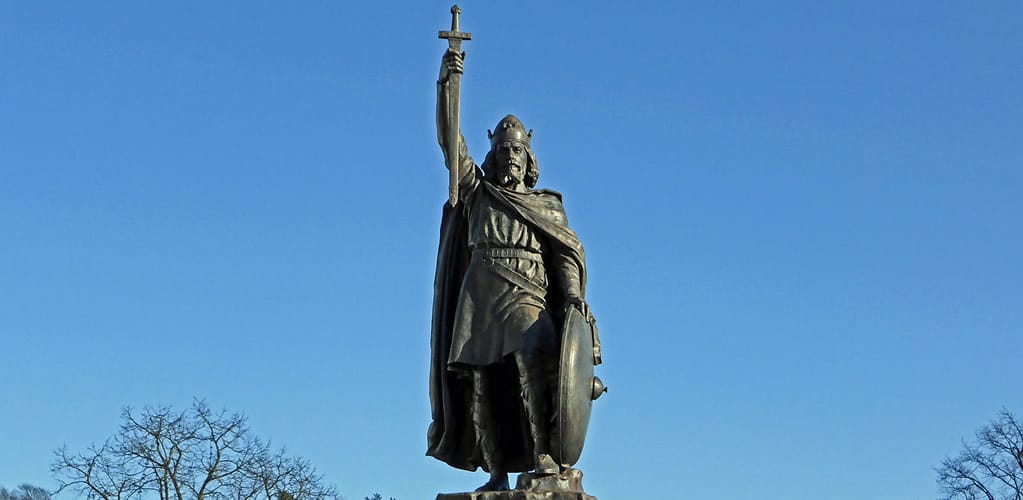It’s a myth that England was created on the battlefield – most of it happened at the negotiating table
Not a simple tale of English kings overcoming Vikings, the creation of England involved far more bureaucracy than the epic legends let on.

Not a simple tale of English kings overcoming Vikings, the creation of England involved far more bureaucracy than the epic legends let on.
T he story of the making of England is often represented as a battleground between the English and the Vikings, with waves of plunder, conquest and combat. Of the multiple English kingdoms, only one, Wessex (based in south-west England), led by Alfred the Great, stopped a great Viking army in its tracks through warfare in the 870s.
Alfred the Great’s grandson Athelstan then secured the future of England by winning the Battle of Brunanburh against a coalition of Vikings and Scots in 937.
This “kings and battles” narrative is well established, but the story is skewed by the propaganda of medieval royals. Stories are important because our views of the past shape perceptions of modern conflict and identities.
The lesser-known part of the creation of England is that it required the suppression of once-independent kingdoms that pre-dated the Viking Age. Also, a close reading of the Anglo-Saxon Chronicle, which is our main source for English history in this period, suggests that integration and negotiation were more important in the making of England than battles and bloodshed.
Arguably, the creation of England was not a simple ethnic conflict between the English and Vikings but a power grab by Wessex, clothed in the garb of saving people from “foreign” oppression.
There is evidence that people living at the time saw events more in terms of regional identities than ethnic binaries. However, the main surviving written sources (such as the Anglo-Saxon Chronicle) were composed under Wessex’s influence and therefore give a one-sided view.
Complicated ethnic identities
From the reign of Alfred to Aethelstan, the power of the kingdom of Wessex gradually extended over the former kingdoms of Mercia (roughly the modern Midlands), East Anglia and Northumbria. Each of these kingdoms had been settled by Vikings from the 860s.
We see regional names “Northumbria” and “East Anglia” used in the Anglo-Saxon Chronicle to describe armies led by Vikings from the 890s. This suggests that a few decades after the Vikings settled, they were identified by the English areas in which they lived. These regional armies presumably combined locals and newcomers. The Vikings were going “native” and a new culture blending Anglo-Scandinavian identities developed in areas under their control.
An English identity was not a barrier to leading Vikings and vice versa. This is illustrated after the death of Alfred the Great when the rule of his son Edward was disputed by a cousin, Æthelwold. Æthelwold led combined armies, including Vikings, but his rebellion was crushed.
In 918, the Mercian Register reports that the Viking leaders of York were willing to pledge obedience to Æthelflæd, leader of English Mercia, shortly before she died.
When Edward seized control of Mercia from Æthelflæd’s daughter, it may have provoked dissent, with a rebellion against him reported at the end of his reign. This isn’t so much an ethnic conflict as reluctance of independent kingdoms to be united under the male line of Alfred the Great.
In the mid-ninth century, the word Angelcynn (literally “Anglian-kin”) appears in charters as an equivalent to gens Anglorum (Latin for “English-speaking people”). The name was promoted in the Viking Age as a unifying label for the peoples of Wessex and Mercia.
Ethnic labelling was important to legitimise new structures of power and to generate a sense of loyalty. Englishness was an identity that people could opt into, even with Scandinavian heritage.
The Anglo-Saxon Chronicle linked the genealogy of Wessex rulers to the Danish royal line. This helped legitimise English leadership over Viking-held areas and develop a sense of shared history.
Forging a new English identity
Traditionally history has been seen to be shaped by decisive conflicts. But England was forged on the negotiating table more than on the battlefield. In relation to Alfred the Great of Wessex and his successors in creating an English kingdom, the most critical conflicts are seen as Edington (878) and Brunanburh (937).
Edington was a significant victory for Alfred as it brought the Viking leader Guthrum into an agreement which included his baptism. Rather than being forced, Guthrum’s baptism may have served an agenda to build links with the church in his new kingdom. Guthrum continued to rule East Anglia until his death in 890.
Brunanburh is sometimes hailed as one of the greatest English victories as Athelstan led the men of Wessex and Mercia to victory against a coalition of Vikings, Scots and Britons. However, the battle was far from decisive.
When Athelstan died two years later, Northumbria came back under Viking control. It was the Northumbrian’s expulsion of their last Viking king, Erik, in 954, and acceptance of the Wessex king Eadred that marked a final chapter in the unification of England.
From 878 to 954, the Anglo-Saxon Chronicle recorded many battles but also many peace treaties and submissions. Peace treaties were often short-lived, but they were important in limiting bloodshed and maintaining lines of communication between rival groups.
It was only once the boundaries of the English kingdom were successfully expanded (a non-linear process which ran from 927 until 954) that royal diplomas began to use derogatory terms, such as “barbarian” to describe non-English, including Viking, customs to promote conformity.
While historians tend to praise the deeds of kings and victorious battles, the work of making England was done through decades long integration and negotiation, swallowing once independent kingdoms into a new political reality. It was only at the end of this process that a narrative of ethnic conflict between English and Viking kings became part of our national story.

GOING FURTHER
The Anglo-Saxon Chronicle | The Medieval and Classical Literature Library
Sources:
▪ This piece was originally published in The Conversation and re-published in PMP Magazine on 25 January 2024. | The author writes in a personal capacity.
▪ Cover: Wikimedia/BobW66. (Licensed under a Creative Commons Attribution-ShareAlike 4.0 International License.)






[Read our Comments Guidelines]